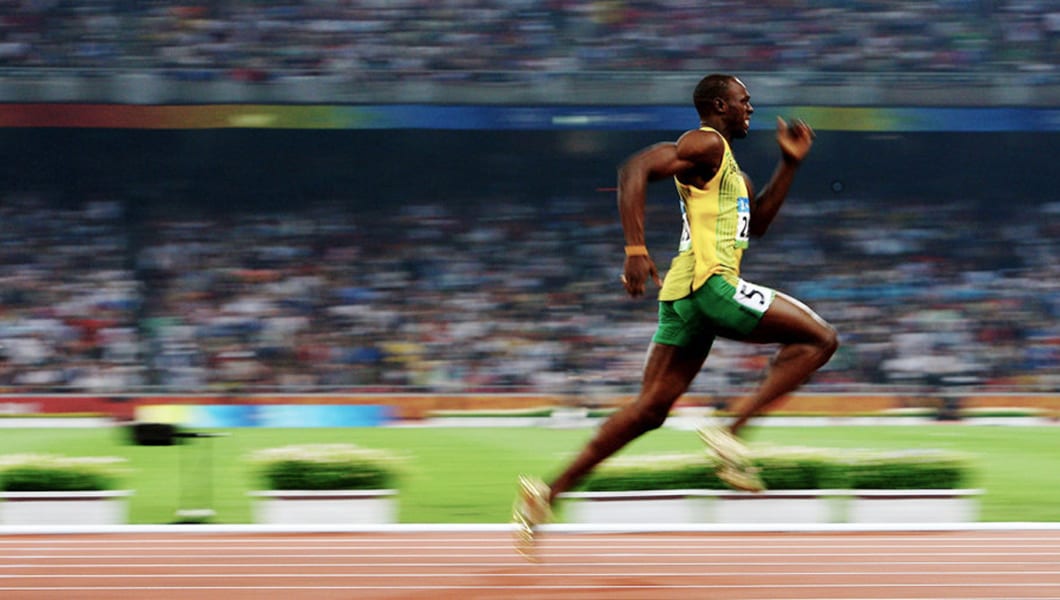The health and science reporter for Quartz magazine, Katherine Ellen Foley, covered the research of SMU biomechanics expert Peter Weyand and his colleagues Andrew Udofa and Laurence Ryan for a story about how world championship sprinter Usain Bolt runs so fast.
The article, “The science explaining how Usain Bolt became the fastest human in the world,” published Aug. 2, 2017.
The researchers in the SMU Locomotor Performance Laboratory reported in June that world champion sprinter Usain Bolt may have an asymmetrical running gait. While not noticeable to the naked eye, Bolt’s potential asymmetry emerged after the researchers dissected race video to assess his pattern of ground-force application — literally how hard and fast each foot hits the ground. To do so they measured the “impulse” for each foot.
Biomechanics researcher Udofa presented the findings at the 35th International Conference on Biomechanics in Sport in Cologne, Germany. His presentation, “Ground Reaction Forces During Competitive Track Events: A Motion Based Assessment Method,” was delivered June 18.
The analysis thus far suggests that Bolt’s mechanics may vary between his left leg to his right. The existence of an unexpected and potentially significant asymmetry in the fastest human runner ever would help scientists better understand the basis of maximal running speeds. Running experts generally assume asymmetry impairs performance and slows runners down.
Udofa has said the observations raise the immediate scientific question of whether a lack of symmetry represents a personal mechanical optimization that makes Bolt the fastest sprinter ever or exists for reasons yet to be identified.
Weyand, an expert on human locomotion and the mechanics of running, is Glenn Simmons Professor of Applied Physiology and professor of biomechanics in the Department of Applied Physiology & Wellness in SMU’s Annette Caldwell Simmons School of Education & Human Development, is director of the Locomotor Lab.
EXCERPT:
By Katherine Ellen Foley
Quartz
Eight years ago, Usain Bolt made history in less than 10 seconds at the International Association of Athletics Federations World Championship in Berlin, Germany.The Jamaican sprinter set the world record for the 100-meter dash, clocking in at 9.58 seconds. Since then, no one (not even Bolt himself) has been able to best that time. On Saturday, August 5, Bolt will once more run the 100-meter dash at the IAAF World Championship (assuming he makes it through the qualifying race on August 4). This will be his last race; Bolt is set to retire after this running season (there’s some speculation he may still race in the 2020 Olympics, although as of now Bolt has said he doesn’t want to).
There’s no such thing as a perfect human running machine. But Bolt comes close—thanks to a combination of having all the advantages of a natural-born sprinter and putting in the effort needed to minimize any of his disadvantages.
Broadly speaking, Bolt has the unique muscular build shared by most of the very best sprinters. All human muscles are made of a mix of slow- and fast-twitch fibers—as well as some that are undifferentiated, and will become slow- or fast-twitch depending on how we use them most often. Slow-twitch fibers are built for efficiency and use oxygen to generate energy from sugar. They’re most effective for activities sustained over a long period of time, like distance running. Fast-twitch muscle fibers are used to generate huge amounts of force, but they don’t use oxygen and as a result can’t carry us far. Training can help shape undifferentiated fibers into either slow- or fast-twitch, but for the most part the best runners were born with an imbalance of one or the other. Elite marathoners have way more slow-twitch fibers, and sprinters like Bolt have an abundance of fast-twitch ones.
The best sprinters also run with a different form than the rest of us. It’s not that they move their legs significantly faster; it’s that they hit the ground harder (paywall). Most of the force sprinters generate is directed straight into the ground for vertical movement; only about 5% is used to propel them forward, Peter Weyand, a physiologist studying human speed at Southern Methodist University in Texas, told Popular Science in 2013. The more force a sprinter can pack into the ground with a quick foot strike, the faster he or she goes.
In a 2010 study, Weyand’s lab conducted an experiment where subjects jogged, ran, and hopped on one foot on a treadmill. They found that the most force came from hopping, thanks to the leg’s longer airtime. The researchers then calculated that if a runner were to generate the maximum hopping force possible with each step, he or she’d be able to reach a speed of 19.3 meters per second (63.3 feet per second)—which would make for a 5.18 second 100-meter dash.
This is just a fun theoretical experiment; it’s impossible to actually sprint and jump straight up and down at the same time. But it appears Bolt generates a powerful punch to the track—maybe the most powerful ever.




